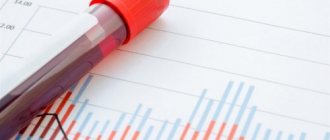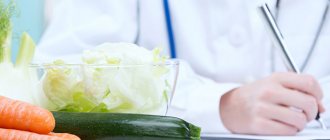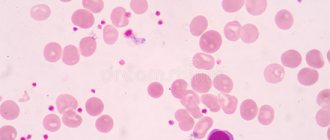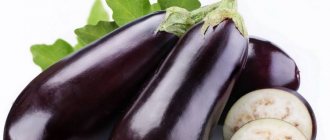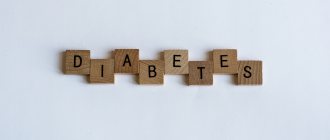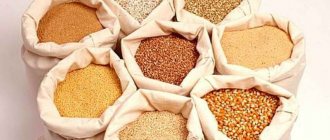A dangerous disease of the endocrine system, diabetes mellitus, does not manifest itself as spontaneously as the flu or food poisoning. A person is inclined to explain the primary signs of poor health by fatigue, poor nutrition “on the go,” and age-related changes in the body. Often, prediabetes and type 2 diabetes are diagnosed in the stage of progressive development only during a routine medical examination or medical examination.
If glucose levels are unstable, the patient is prescribed therapeutic nutrition. To control the disease, you need to know which foods lower blood sugar and which cause hyperglycemia and subsequent complications. The diagnosis of diabetes mellitus involves changes in lifestyle, eating behavior and permanent monitoring of blood sugar levels.
Basic nutrition rules
In case of diabetes mellitus, it is necessary to follow nutritional rules that help improve the patient's condition.
- Counting grain units (XE), (UE). This is a daily must for insulin-dependent patients. One such indicator is equal to 12-15 g of easily digestible carbohydrates and increases SC by 2 mmol/l. The diet can be changed if the value of XE in food is known. It is recommended to replace bread units with food that is similar in the rate of absorption of substances. All vegetables other than potatoes can be ignored, but other foods with carbohydrates must be counted.
- BZHU. It is worth dividing the consumption of proteins, fats and carbohydrates evenly throughout the day between 5 meals. It is better to take fruit as a snack.
- Simple carbohydrates. It is advisable to avoid or completely remove easily digestible organic compounds from the diet. This list includes semolina, rolled oats, mashed potatoes, jam, candies, marshmallows, marmalade, condensed milk, halva, jam, etc.
- Cellulose. For diabetes mellitus, vegetables are consumed three times a day. More fiber and less refined foods. To make diet planning easier, there is a formula: 50% - vegetables, 25% - carbohydrates, 20% - proteins, 5% - mixed foods.
- Starvation. It is strictly forbidden to go hungry; it is not only harmful, but also increases the risk of buying unhealthy foods.
- Weight loss. It’s worth getting rid of extra pounds gradually but steadily. An excellent result is considered to be 3 kg per month. If you have diabetes, short-term diets and taking fat-burning medications are prohibited. When glucose levels drop, the body stores fat.
- Reducing salt. Consumption of the product should be kept to a minimum. Salt retains fluid in the body, which increases blood pressure and increases the load on the kidneys.
- Alcohol. In rare cases, you can drink alcohol, but it is worth remembering that it contains calories and increases the risk of hypoglycemia.
- Fresh food. There is no need to prepare food for future use; the healthiest thing is a freshly prepared dish.
These are the basic rules of healthy eating and recommendations for people with diabetes.
Why is blood sugar control necessary?
Impaired glucose absorption affects the condition of many internal organs and changes metabolic processes. Often, glucose levels rise precisely because patients are malnourished.
Refined, refined foods, improper cooking methods and processed foods overload the daily menu with substances hazardous to health.
Required rate
Any person with or without diabetes should strive for a level of up to 5.5 mmol/l 1-2 hours after each meal and in the morning on an empty stomach. A stable glucose level means a minimal risk of developing all kinds of complications of the pathology of the endocrine system.
Diet and non-insulin-dependent disease
Dietary restrictions are especially important for type 2 diabetes. The entire nutrition scheme is aimed at the following goals:
- weight loss, if necessary;
- prevention of a sharp increase in sugar.
The initial form of type 2 diabetes can be corrected with just nutrition, so the choice of ingredients for the daily menu should be very important. The moderate and severe stages of the disease cannot be avoided without drug treatment along with a strict diet.
The calorie content of foods depends on the patient's weight. If you are overweight, you will need a low-calorie diet.
In type 1 pathology, pancreatic cells die, causing insufficient insulin to be produced. In this case, replacement therapy plays a major role, and nutrition helps maintain normal weight and well-being.
Menu for a diabetic patient
What sweeteners are allowed?
Sweeteners are sugar substitutes whose production began in the 20th century. Modern drugs are almost harmless. There are two types of sweeteners:
- Natural sweetener (sorbitol, xylitol, stevioside, fructose). Obtained by heat treatment of plants. When they are consumed, the body produces a small amount of energy. You cannot take more than 4 g per day. For diabetes and obesity, a doctor's consultation is necessary.
- Artificial sweetener (aspartame, saccharin). When substances decompose, the human body does not absorb energy. These substitutes are sweeter than glucose, but the calorie content is zero. The drugs are great for people with diabetes.
According to research, sucralose and stevia cannot cause the development of negative reactions. Due to their safety, no processes in the body change after their use.
Fresh fruit juice
Fruit juice has been promoted for decades as an all-natural, healthy drink that's just as good as whole fruit. But 1 fresh orange provides fiber, carbohydrates and vitamins while delivering only 15 grams of carbohydrates.
Fruit juice doesn't provide as much fiber and nutrients, but does have 45 grams of carbohydrates per glass. It can only be used for hypoglycemia, when you need to quickly decide how to increase your sugar. It is better to use fresh and frozen fruits in your daily diet. They contain fewer light carbohydrates.
What foods help lower glucose?
If you have high blood sugar and diabetes, it is recommended to eat foods that reduce glucose concentrations daily.
- Oatmeal. It contains a lot of fiber, thanks to which cereal normalizes sugar levels and prevents the development of diabetes.
- Nuts. Cashews, walnuts, almonds, peanuts, and hazelnuts contain proteins, fiber, and fats. These substances slow down the absorption of glucose. Do not exceed a single portion of the product – 50 g.
- Cinnamon. The spice has the ability to control sugar levels due to magnesium, fiber, and polyphenols. Therefore, it can be added to drinks, sauces, juices, and cereals.
- Avocado. The composition of the healthy product has a beneficial effect on the entire body, strengthening the immune system and lowering blood glucose.
- Red sweet pepper. The low-calorie product saturates the body with antioxidants and vitamin C. Lowers sugar, fights inflammation and infectious diseases.
- Millet. The grains are high in fiber and contain no sugar. Also used as a prophylactic against diabetes. To reduce the risk of developing the disease by 20-30%, you need to eat a bowl of porridge with millet a day.
- Fish. The product should be added to the diet at least twice a week. Only oven-baked or steamed fish can lower glucose levels.
- Broccoli. Polyphenols contained in the vegetable reduce inflammation. It is precisely such processes in the body that are not controlled that often lead to the development of diabetes.
- Legumes. When you are sick, you need to eat beans, lentils, and peas. They slow down the absorption of sugar and prevent the development of the disease by 45%.
- Strawberry. Berries are sources of vitamin C, fiber, and antioxidants. Seasonal strawberries normalize glucose levels and prevent diabetes.
- Jerusalem artichoke. The vegetable contains a lot of fructose and insulin. Thanks to these components, it reduces sugar, removes harmful substances from the body, and restores metabolism. Can be crumbled into salads or eaten raw.
- Garlic. Adding the product to food normalizes the functioning of the pancreas, resulting in increased insulin production. A positive effect on metabolic processes is noted due to the high content of antioxidants.
These are the main foods that should be in the diet of a person with diabetes.
Recommended video:
Foods with high and medium GI
There is no need to calculate the glycemic index yourself. There is a ready-made table of foods that are excluded from the diet of a diabetic patient.
| Products | G.I. |
| dates | 146 |
| wheat bread (white) | 136 |
| cakes, cookies, croutons (fried) | 100 |
| potatoes (fries and fried) / mashed | 95/90 |
| pies and buns | 88 |
| corn flakes, popcorn and pasta | 85 |
| rice porridge, waffles, caramel candies | 80 |
| fried zucchini, baked pumpkin | 75 |
| seasoned croutons, soda | 74 |
| watermelon | 72 |
| cheesecakes, ice cream, jam (jams), milk chocolate, halva, dumplings | 70 |
Nutritional features must comply with:
- stages of the disease (compensated, subcompensated, decompensated);
- type of disease (insulin dependent, non-insulin dependent);
- prescribed doses of medications;
- the presence of complications and concomitant pathologies;
- general condition of the patient;
- level of physical activity.
Depending on the listed individual health indicators, food with an average GI value is allowed. The treating endocrinologist can best advise which foods should be avoided and which ones can be eaten. The table shows limited products with an average glycemic index.
| Products | Gl |
| unleavened dough (flatbread, pita without filling) | 69 |
| croissants without filling | 67 |
| muesli, pineapple, diet biscuit | 66 |
| bananas, melon, boiled jacket potatoes | 65 |
| raisin | 64 |
| pizza with tomatoes (without meat filling) | 60 |
| papaya | 58 |
| mango, oatmeal cookies, persimmon | 55 |
| yoghurts, tomato soup, gazpacho type | 52 |
| buckwheat, buckwheat flour pancakes | 50 |
| green peas (canned) | 48 |
| beans (white, red), kiwi | 42 |
| chickpeas | 41 |
Excessive consumption of foods from the medium glycemic category can negatively affect health. Sugar will increase depending on the amount eaten, since a larger volume of food containing glucose requires greater insulin costs. With insulin deficiency, hyperglycemia may develop. Proper nutrition is a method of treating diabetes. Neglecting recommendations leads to severe complications of the disease.
What can you drink if you have diabetes?
If you have diabetes, you can drink drinks, but not all of them and in a certain quantity.
- Water. Hydration has a beneficial effect on a person’s emotional and physical well-being. Thirst is often mistaken for sugar cravings or hunger.
- Herb tea. When boiling water, adding plants will make the drink more delicious. For example, licorice root will make it a little sweeter without raising your blood glucose levels.
- Flavored water. If it is not possible to drink clean water often, you can add lemon, lime or cranberry juice. A mixture of water and aloe vera pulp will also be helpful.
- Milk. Soy, rice or skim milk contain substances necessary for diabetes. You should not take products that contain sugar or other sweeteners.
- Tea coffee. Drinks can be drunk, but only in moderation. A little caffeine won't hurt, as long as you don't add cream or sugar.
- Fruit juice. The freshly squeezed drink is allowed to be consumed if you have diabetes. A small amount of it will not increase blood glucose levels if taken into account in the diet.
These are the main drinks included in the diet. If you have diabetes, you should not drink sweet fruit smoothies, soda, energy drinks, or alcohol.
Dish bomb
The recipe combines delicious and healthy ingredients. The dish turns out to be low-calorie and satisfying. Cook on an electric grill, or if you don’t have one, use a grill pan.
Seafood with grilled vegetables
Ingredients (for two servings):
- shrimp - 200 g;
- mussels - 200 g;
- squid - 200 g;
- salad mix - 400 g;
- zucchini - 200 g;
- tomatoes −300 g;
- eggplants - 300 g;
- fresh herbs - a bunch;
- green onions - 4 arrows;
- ginger root - 8 g;
- balsamic vinegar - 2 teaspoons.
Step by step
- Cut zucchini, tomatoes, eggplant into thin slices. Grill.
- Clean the squid, shrimp, and rinse the mussels.
- Fry seafood in a frying pan with a minimum amount of oil.
- Add green onions, herbs, and ginger to the seafood.
- Salt, pepper, add prepared vegetables, mix.
- Drizzle with balsamic vinegar and serve.
Products strictly prohibited for diabetes
If you have hyperglycemia due to diabetes, you should not eat certain foods. They are removed from the diet or eaten in minimal quantities with glucose calculations.
| Bread | Baking, biscuit, cake, pastries, loaf. |
| Milk products | Cream, including whipped cream |
| Soups | From fatty fish, lard, pork, with pasta, dumplings. |
| Fish | Caviar, canned food in oil, salted fish. |
| Meat, poultry | Pork, smoked meats, fatty goose, duck. |
| Vegetables | Potatoes, canned vegetables with garlic and pepper. |
| Cereals | Semolina. |
| Fruits, sweets | Chocolate products, bananas, raisins, grapes, candies. |
| Beverages | Semi-sweet wine, dessert wine, carbonated wine, lemonade, packaged nectars and juices. |
Of the fats, it is strictly forbidden to consume lard, both raw and as fried food.
Examples of a balanced breakfast, lunch and dinner
Menu planning is the main task for a diabetic. We must assume that the maximum calorie content is 1800-2000 kcal per day. Based on this, the composition and quantity of products for each meal are selected.
Breakfast
For tomorrow you can prepare dishes from the following products:
- rye bread (50 g) and butter (5-7 g);
- boiled chicken egg;
- milk glass (200 ml);
- porridge from any cereal (100 g).
Instead of porridge, you can include one of the following dishes:
cottage cheese with a moderate fat content of 4-5% (100 g);
- apple;
- plum;
- peach;
- apricot;
- any citrus (except lemon, lime).
The fruit should be of medium size - the weight in terms of pure pulp is about 100 g. Moreover, it is better to leave the fruit for an afternoon snack as a separate meal. Instead, you can use half a glass of milk (100 ml) for a snack.
Dinner
Lunch is the main meal, so it should be complete. For example, for a proper lunch you can consider the following dishes:
- fish soup or chicken soup (you can use broth with lean meat) 150 ml;
- boiled meat 100 g;
- boiled potatoes 100 g;
- black bread 50 g;
- raw or boiled vegetables 200 g;
- fruit (from those listed above) 100 g.
Dinner
A complete dinner can be prepared using the following products:
- boiled potatoes 100 g;
- any fish (low-fat) 100 g;
- fruits or vegetables 100 g;
- black bread 30 g.
Finally, as a late dinner (1-1.5 hours before bedtime), you can use a glass of low-fat kefir.


